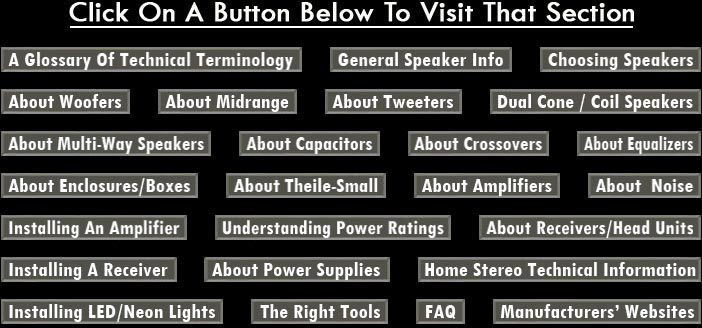


Magnet/Magnet Structure
A combination of magnetic material and connected field concentrators that creates the magnetic field within which the voice coil interacts to produce sound. Magnetic materials have changed greatly over the years to produce much higher concentrations of magnetic fields (rated in gauss) with lighter and smaller volumes of material.
In marketing speakers, a great deal of hype is often applied to the question of magnet weight. But many of these claims should be treated with skepticism. With greater and greater concentrations of gauss fields being developed from ever lighter and smaller mass metallurgical materials, the only good measure of adequate power handling is the manufacturer's RMS Wattage rating. Hefty magnets may look impressive, but while capable,they are no longer an essential index to a speaker's power capacity.
Magnet Boot
A rubber or plastic cover for the magnet housing for protection or appearance, mostly the latter.
Magnetic Flux Density
The measurement of magnetic flux, in units of Gauss, inside the air gap in which a voice coil of a speaker operates.
MASH
An acronym for Multi-stage noise shaping. This is the name given to the digital advances that were introduced after the CD specification had been established.
MAX (see Peak Power Handling and separate article on Power rating)
Memory
The word most commonly used to refer to a system's ability to retain specific information, particularly; time, stations,.and other preference settings that are electronically stored and governed.
Memo List
A Custom File feature that allows the user to toggle through the discs, selection titles, or station call letters currently loaded without interrupting playback of the existing disc or station.
Metal Tape EQ
An equalization circuit that compensates for the unique frequency response characteristics of metal tape.
Microbar
1. A unit of atmospheric pressure equal to one millionth of a bar. 2. A place to consume the product of microbreweries.
Microprocessor
A multiple semiconductor IC device that can be dedicated or programmed to perform a variety of tasks in many different systems. These exist in virtually all consumer and commercial electronic devices of more than rudimentary functionality.
Midbass
Those frequencies roughly between 100 and 300 Hertz. (CPS)
MIDI
Acronym for Musical Instrument Digital Interface, a standard adopted by the electronic music industry for controlling devices, such as synthesizers and sound cards, that produce music. At minimum, a MIDI representation of a sound includes values for the note's pitch, length, and volume, but can also include additional characteristics, such as attack and decay time.
MIDI files
A computer file format containing musical information and performance data capable of being used in MIDI capable devices.
Midrange
A Driver that is usually much smaller than a woofer, but with a surface area greater than the typical tweeter. It reproduces the mid frequency range from approximately 300 to 5000 Hertz. This optimum range can vary considerably from one driver to the next, thus giving the system designer more flexibility in choosing Crossover points for the other drivers.
Milliamps
A unit of measurement of electric current equal to 1/1000th of an ampere. The milliampere is the most common unit used when measuring quiescent current drain in consumer audio electronics.
Mixer
At its simplest level, an audio processing device used to add (combine or sum) multiple inputs into one or two outputs, complete with level controls on all inputs. From here signal processing is added to each of the inputs and outputs until behemoth monsters with as many as 64 inputs are created -- at a cost of around 10-20 thousand dollars per input for fully digitized and automated boards.
Mono (monaural)
The operation of an amplifier in one channel for both input and output. Can refer to an amplifier with only one channel of amplification or operating in bridged mode. For low frequency amplification applications, it provides better phase coherence and less distortion than stereo operation.
MOSFET (Metal Oxide Semiconductor Field Effect Transistor)
A type of large output transistor used in the final stages of many power amplifiers, and commonly found in most car and home amplifiers today. These field-effect transistors are controlled by voltage rather than current, like a bipolar transistor. MOSFETs have a significantly higher switching speed than bipolar transistors. They generate almost no loss (little heat generation), which lends the power supply fast response, excellent linearity, and high efficiency.
Mosfet transistors are most often discrete devices, used with smaller driver transistors and other devices, to convert a small signal to a large one. They are highly stable and efficient, compared to the bipolar types that preceded them.
MOSFET Power Supply
A power supply that employs MOSFET transistors to convert DC to AC. Offers superior thermal stability and more accurate switching.
Motor Structure
In speakers, the complete sound generator or transducer that converts incoming electrical signals to mechanical/acoustic energy or sound. In a dynamic Driver, this includes the magnet, its directive field concentrators or Pole Pieces, and the voice coil that interacts with them.
Mounting Depth
The amount of physical space required to mount a Driver without having any of its parts touch objects below. This is particularly relevant to car speakers where such mounting spaces may be sharply limited as to their ability to accommodate deep speakers with large magnets. Door panels with movable windows are a typical example of where care must be taken in selecting speakers to be mounted. (see Mounting Ring, below)
Mounting Ring
Often used to describe the circular gasket seal incorporated into the edge of a speaker, traditionally the term "mounting ring" refers to a separate device placed between a Driver and the surface on which it is mounted, for the effect of raising the speaker so that larger and deeper speakers can be accommodated in limited spaces. (see Mounting Depth, above).
MP3, mp3
Is the file extension for MPEG, audio layer 3. Layer 3 is one of three coding schemes (layer 1, layer 2 and layer 3) for the compression of audio signals. Layer 3 uses perceptual audio coding and psychoacoustic compression to remove all superfluous information (that, in the opinion of the developers, the human ear doesn't hear anyway). It also adds an algorithm that increases the frequency resolution 18 times higher than that of layer 2. The result is mp3 encoding shrinks the original sound data from a CD by a factor of 12 without sacrificing sound quality.
Mute
A control found on receivers, some mixers, and certain signal processing units that silences (mutes) a signal path, or output. 2. Someone with much to say but lacking the hardware or software to do so.
Multimeter
A common term used to describe a VOM. A multimeter usually has the ability to measure volts, ohms, and amperes or milliamperes.
Multi-tracking
The process of recording a multi-part performance on separate tracks at different times which allows the engineer to subsequently combine, balance and process those tracks during mixdown.















